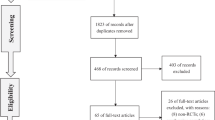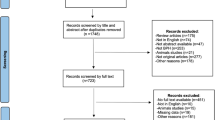Abstract
Objectives
With the maturity of cryotherapy for prostate cancer, the complications after operation are also decreasing, which can improve the prognosis of patients. However, erectile dysfunction (ED) is still one of the main complications after cryotherapy. Therefore, we performed a meta-analysis to evaluate the incidence of erectile dysfunction in patients after cryotherapy.
Materials and methods
A comprehensive literature search was performed in August 2018. PUBMED and EMBASE databases were searched to collect studies reporting the incidence rate of ED after cryotherapy from 2002 to 2018. Two reviewers independently screened the literatures, extracted data and assessed the risk of bias of included studies. Pooled ratio and its 95% confidence intervals (95% CIs) were performed by Stata 12.1.
Results
Of the 157 articles identified on August 1st 2018, 23 studies which reported ED after cold ablative therapy were identified, however, only 12 used validated outcome measures and met inclusion criteria. A total of 12 studies were included in this meta-analysis. Overall, the results of this meta-analysis showed that the pooled incidence rate of ED was 0.27 (95% CI 0.26–0.28) which means that the incidence rate of ED after cryotherapy for prostate cancer was not high, but we still found that there are great heterogeneity between the 12 articles. By subgroup analysis, we found a statistically significant incidence rate of ED in primarily localized PCa which was 0.49 (95% CI 0.30–0.68), which is clearly lower than the incidence of recurrent prostate cancer after failed primary radiotherapy 0.61 (95% CI 0.43–0.79).
Conclusion
ED is one of the major complications after cryotherapy for PCa. Furthermore, subgroup analysis revealed a higher incidence rate in PCa undergoing radiotherapy. Significantly, with the development of cryotherapy technology, the incidence of ED after cryotherapy for prostate cancer is decreasing. While we still need further researches to advance knowledge in this field.





Similar content being viewed by others
References
Boring CC, et al. Cancer statistics, 1994. CA Cancer J Clin. 2010;40(1):9–26.
Lian H, et al. Cryosurgery as primary treatment for localized prostate cancer. Int Urol Nephrol. 2011;43(4):1089–94.
Cooperberg MR, et al. The changing face of low-risk prostate cancer: trends in clinical presentation and primary management. J Clin Oncol. 2004;22(11):2141–9.
Han M, et al. Biochemical (prostate specific antigen) recurrence probability following radical prostatectomy for clinically localized prostate cancer. J Urol. 2003;169(2):517–23.
Roach M, et al. Four prognostic groups predict long-term survival from prostate cancer following radiotherapy alone on Radiation Therapy Oncology Group clinical trials. Int J Radiat Oncol Biol Phys. 2000;47(3):609–15.
Robinson JW, Moritz S, Fung T. Meta-analysis of rates of erectile function after treatment of localized prostate carcinoma. Int J Radiat Oncol Biol Phys. 2002;54(4):1063–8.
Shah S, Young HN, Cobran EK. Comparative effectiveness of conservative management compared to cryotherapy in localized prostate cancer patients. Am J Men’s Health. 2018;12(5):1681–91.
Asterling S, Greene DR. Prospective evaluation of sexual function in patients receiving cryosurgery as a primary radical treatment for localized prostate cancer. BJU Int. 2009;103(6):788–92.
Ward JF, Jones JS. Focal cryotherapy for localized prostate cancer: a report from the national Cryo On-Line Database (COLD) Registry. BJU Int. 2012;109(11):1648–54.
Kim FJ, et al. Initial Brazilian experience in the treatment of localized prostate cancer using a new generation cryotechnology: feasibility study. Int Braz J Urol. 2012;38(5):620–6.
Roberts CB, et al. Treatment profile and complications associated with cryotherapy for localized prostate cancer: a population-based study. Prostate Cancer Prostatic Dis. 2011;14(4):313–9.
Anastasiadis AG, et al. Comparison of health-related quality of life and prostate-associated symptoms after primary and salvage cryotherapy for prostate cancer. J Cancer Res Clin Oncol. 2003;129(12):676–82.
Gevorgyan A, et al. Cryothérapie prostatique de rattrapage après échec de radiothérapie externe ou curiethérapie: morbidité et résultats oncologiques à moyen terme. Progrès en Urologie. 2018;28(5):291–301.
Ismail M, et al. Salvage cryotherapy for recurrent prostate cancer after radiation failure: a prospective case series of the first 100 patients. BJU Int. 2007;100(4):760–4.
Philippou P, Yap T, Chinegwundoh F. Third-generation salvage cryotherapy for radiorecurrent prostate cancer: a centre’s experience. Urol Int. 2012;88(2):137–44.
Ellis DS. Cryosurgery as primary treatment for localized prostate cancer: a community hospital experience. Urology. 2002;60(2 Suppl 1):34–9.
Barqawi A, et al. Prospective outcome analysis of the safety and efficacy of partial and complete cryoablation in organ-confined prostate cancer. Urology. 2018;112:126–31.
Cappelleri JC, Rosen RC. The Sexual Health Inventory for Men (SHIM): a 5-year review of research and clinical experience. Int J Impot Res. 2005;17(4):307–19.
Rosen RC, Cappelleri JC, Gendrano N. The International Index of Erectile Function (IIEF): a state-of-the-science review. Int J Impot Res. 2002;14(4):226–44.
Siegel RL, Miller KD, Jemal A. Cancer statistics, 2018. CA Cancer J Clin. 2018;68(1):7–30.
Robinson JW, et al. Quality-of-life outcomes for men treated with cryosurgery for localized prostate carcinoma. Cancer. 1999;86(9):1793–801.
Onik GM, et al. Transrectal ultrasound-guided percutaneous radical cryosurgical ablation of the prostate. Cancer. 1993;72(4):1291–9.
Eton DT, Lepore SJ. Prostate cancer and health-related quality of life: a review of the literature. Psycho Oncol. 2002;11(4):307–26.
Ponholzer A, et al. Prevalence and risk factors for erectile dysfunction in 2869 men using a validated questionnaire. Eur Urol. 2005;47(1):80–6.
Higgins JPT, Thompson SG. Quantifying heterogeneity in a meta-analysis. Stat Med. 2002;21(11):1539–58.
Bax L, et al. More than numbers: the power of graphs in meta-analysis. Am J Epidemiol. 2008;169(2):249–55.
Seagroatt V, Stratton I. Bias in meta-analysis detected by a simple, graphical test. Test had 10% false positive rate. BMJ. 1997;316(7129):469–471.
Consensus development conference statement. National institutes of health. Impotence. December 7–9, 1992. Int J Impot Res. 1993;5(4):181–284.
Shamloul R, Ghanem H. Erectile dysfunction. Lancet. 2013;381(9861):153–65.
Author information
Authors and Affiliations
Corresponding author
Ethics declarations
Conflict of interest
The authors certify that there is no conflict of interest regarding this manuscript.
Research involving human participants and/or animals
This article does not contain any studies with human participants or animals performed by any of the authors.
Informed consent
For this type of study, formal consent is not required.
Additional information
Publisher's Note
Springer Nature remains neutral with regard to jurisdictional claims in published maps and institutional affiliations.
Rights and permissions
About this article
Cite this article
Zhou, J.T., Fang, D.M., Xia, S. et al. The incidence proportion of erectile dysfunction in patients treated with cryotherapy for prostate cancer: a meta-analysis. Clin Transl Oncol 21, 1152–1158 (2019). https://doi.org/10.1007/s12094-019-02036-8
Received:
Accepted:
Published:
Issue Date:
DOI: https://doi.org/10.1007/s12094-019-02036-8




